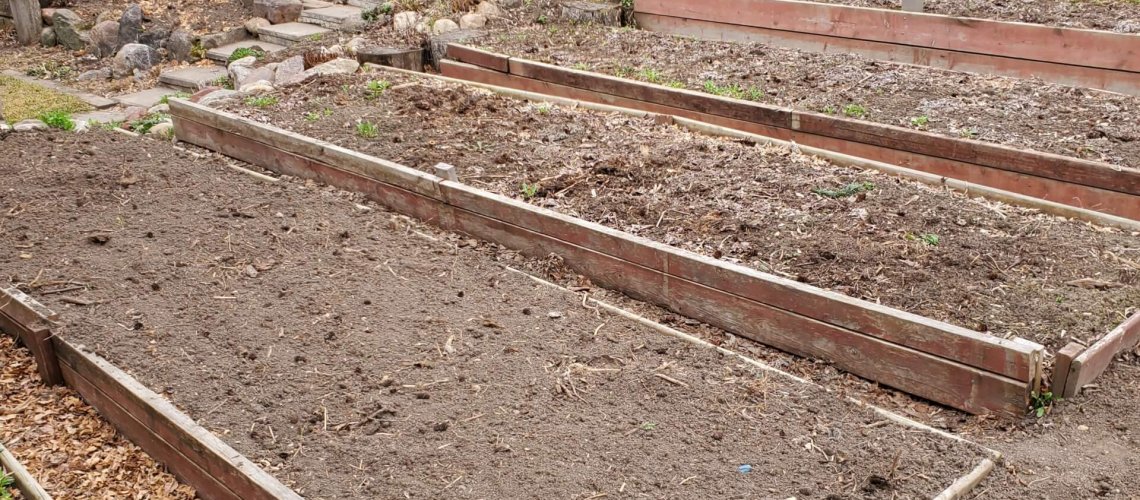The author John Updike stated, Rain is grace; rain is the sky descending to the earth; without rain, there would be no life. In the cartoon Maxine, Maxine said, A garden is worth a medicine cabinet of pills.
Spring is when my love for gardening blossoms. While spring is a time of optimism, don’t forget summer is coming and you have to look after your garden. Don’t take on more than you can handle. Keep an eye on the weather and adjust accordingly. And follow your plan.
Most of my garden is made up of raised beds. And because I practice no-till, I only use a broad fork on the bed used for the brassica family, cabbage and kale, and turnip. If this is your first garden, dig, add compost, and make sure the surface is smooth. Base the amount you plant on the space you have available.
Each year I rotate my vegetables moving from heavy feeders (tomato, squash, brassica) to heavy givers, peas, or beans, to light feeders or root vegetables. The rotation fools, to some extent, garden pests that tend to return to where they grew up.
Some vegetables can be planted early in the season, others later. This first of two articles discuss when and how to plant hardy vegetables. Actual dates will depend on long-range weather reports.
FYI: 10 cm = 4” 1m = 3’- 3”
Garlic: Plant in late fall of the previous year. Break cloves from a garlic head and plant each clove about 20 cm apart with the pointy end up about 5 cm deep in loose soil. Cover the area with mulch.
Spinach: In the late fall, plant a short row, about 1 m, with a 7 cm seed spacing. In the spring plant another row in early May. Spinach is a cool-weather crop that does best in the spring and fall. It prefers well-drained, rich soil and a sunny location. Keep the soil moist. I have had great success with a broadleaf spinach Emelia F1.
In early May, depending on the long-range forecast, plant the following:
Cabbage: Plant in rows 50 cm apart. Cabbage seeds germinate quickly. Once they have sprouted, thin to 45 cm apart. Once thinned, cover the seedlings with a row cover to prevent root maggot flies and cabbage moths from laying their eggs. Danish Ballhead and Golden Acre are two of my seed choices.
Danish Ballhead may keep longer. For red cabbage, try Red Express.
Carrots: Plant in rows 15 to 20 cm apart. Carrots are slow germinators taking up to two weeks or more. Once germinated, thin to approximately 10 cm; you will get much larger carrots. I prefer Nantes or Danvers seeds.
Lettuce: Plant in short rows about 20 cm apart, every two or three weeks. After sprouting, immediately thin to a 7 cm spacing. Because lettuce is shallow-rooted, keep the soil damp.
Kale: One or two plants will feed a family of four.
Onions: I purchase onion sets, yellow, white, or red, preferably long-day sets that keep longer. Plant 15 cm apart in rows spaced about 20 cm apart. Because onions are shallow-rooted, water weekly.
Parsnips: Plant in rows 20 cm apart. Parsnips are slow to germinate. Then thin to 10 cm.
Peas: Plant in early May. If you wish to have a continuous supply of fresh peas, plant short rows every two weeks so you can harvest fresh peas over a period of time. You will need a climbing fence, preferably chicken wire. As peas are tall climbers, place them where they do not shade shorter vegetables. I prefer the Lincoln variety.
Swiss Chard: A 3m row should be sufficient to feed a family of four. Once the seeds germinate, thin to about 15 cm spacing.
Turnip or Rutabaga: Plant in rows 40 cm apart and thin to 30 cm. Once they are thinned, place a row cover over them. I prefer the Laurentian variety; it keeps well.
The next article will discuss planting frost-sensitive plants.

One Response
Thanks for your advice, I am a gardener and will be starting early, as you suggest.
ALL THOSE GARDEN THINGS
Have you seen my tomatoes, they’re the biggest I’ve ever grown
And my beans and zucchini are the tastiest I’ve ever known
Harvest time this year, is as exciting as every other
A tradition of creation, passed on from father and mother
When you plant your own garden, it’s like going to a shrink
There is therapeutic value in the things you have to think
Don’t plant it all too early, or your seeds will not come up
Don’t plant it all too late, or your harvest won’t be enough
Put your beans in front and the corn way in the back
If you hill all your potatoes, you’ll be able to fill a sack
I’m feeling so much better, when the sun is on my face
And I’m standing and admiring my beautiful garden space
When I’m picking all the ripe ones and eating just a few
I’m planning out our menu and I’ll be sharing it with you
The pride that I am feeling is the joy my garden brings
My days are filled with pleasure, with all those garden things